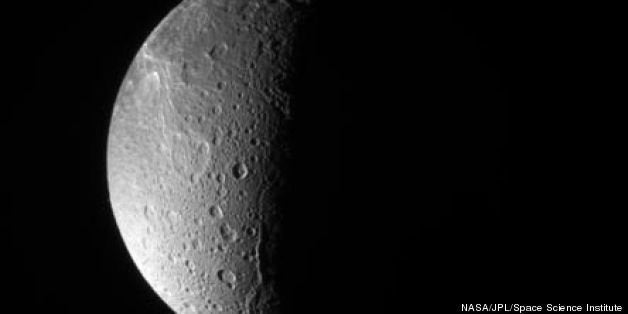The plain-looking Saturn moon Dione may have once had a geologically active subsurface ocean, new images from NASA's Cassini spacecraft reveal.
Images of Dione's 500-mile-long (800 kilometers) mountain Janiculum Dorsa suggest that the moon could have been a weaker copycat of Enceladus, Saturn's icy geyser moon.
"There may turn out to be many more active worlds with water out there than we previously thought," Bonnie Buratti, who leads the Cassini science team at NASA's Jet Propulsion Laboratory in Pasadena, Calif., said in a statement.
Subsurface oceans are thought to exist on several bodies in the solar system, including Saturn's moons Enceladus and Titan and Jupiter's moon Europa. These geologic hotspots have garnered the interest of scientists searching for the building blocks of life beyond Earth. If Dione turned out to have a liquid layer under its crust, that would increase the moon's chances of supporting life.
Cassini, which has been exploring Saturn since 2004, detected a weak particle stream coming from Dione with its magnetometer. Images taken by the spacecraft suggest a slushy liquid layer might exist beneath its icy crust, as well as ancient, inactive fractures that now spew water ice and carbon-containing particles, much like ones seen on Enceladus.
Dione's Janiculum Dorsa ranges from about 0.6 to 1.2 miles (1 to 2 kilometers) in height. The mountain seems to have deformed the icy crust underneath by as much as 0.3 mile (0.5 kilometer). The deformation implies the crust was warm, most likely from a subsurface ocean when the mountain formed, the researchers said.
As Dione swings around Saturn, it gets squished and stretched, causing it to heat up. When you have a subsurface ocean that lets the icy crust float around on top, Saturn's gravitational pull becomes amplified and generates 10 times more heat, the researchers said. The heating could also be caused by a local hotspot or a crazy orbit, but these explanations are less likely.
Scientists don't know why Dione hasn't been as active as Enceladus. The latter may have experienced stronger gravitational forces or more radioactive heating in its core, they suggest. Subsurface oceans appear to be common on icy satellites, and could exist on dwarf planets like Ceres and Pluto.
Cassini's recent findings were reported in March in the journal Icarus.
Follow Tanya Lewis on Twitter and Google+. Follow us @Spacedotcom. We're also on Facebook & Google+. Original article on SPACE.com.
Copyright 2013 SPACE.com, a TechMediaNetwork company. All rights reserved. This material may not be published, broadcast, rewritten or redistributed. ]]>
Support HuffPost
Our 2024 Coverage Needs You
Your Loyalty Means The World To Us
At HuffPost, we believe that everyone needs high-quality journalism, but we understand that not everyone can afford to pay for expensive news subscriptions. That is why we are committed to providing deeply reported, carefully fact-checked news that is freely accessible to everyone.
Whether you come to HuffPost for updates on the 2024 presidential race, hard-hitting investigations into critical issues facing our country today, or trending stories that make you laugh, we appreciate you. The truth is, news costs money to produce, and we are proud that we have never put our stories behind an expensive paywall.
Would you join us to help keep our stories free for all? Your contribution of as little as $2 will go a long way.
Can't afford to donate? Support HuffPost by creating a free account and log in while you read.
As Americans head to the polls in 2024, the very future of our country is at stake. At HuffPost, we believe that a free press is critical to creating well-informed voters. That's why our journalism is free for everyone, even though other newsrooms retreat behind expensive paywalls.
Our journalists will continue to cover the twists and turns during this historic presidential election. With your help, we'll bring you hard-hitting investigations, well-researched analysis and timely takes you can't find elsewhere. Reporting in this current political climate is a responsibility we do not take lightly, and we thank you for your support.
Contribute as little as $2 to keep our news free for all.
Can't afford to donate? Support HuffPost by creating a free account and log in while you read.
Dear HuffPost Reader
Thank you for your past contribution to HuffPost. We are sincerely grateful for readers like you who help us ensure that we can keep our journalism free for everyone.
The stakes are high this year, and our 2024 coverage could use continued support. Would you consider becoming a regular HuffPost contributor?
Dear HuffPost Reader
Thank you for your past contribution to HuffPost. We are sincerely grateful for readers like you who help us ensure that we can keep our journalism free for everyone.
The stakes are high this year, and our 2024 coverage could use continued support. If circumstances have changed since you last contributed, we hope you’ll consider contributing to HuffPost once more.
Already contributed? Log in to hide these messages.

